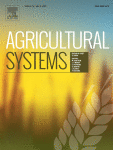View Item
- xmlui.general.dspace_homeCentros Regionales y EEAsCentro Regional Santa FeEEA RafaelaArtículos científicosxmlui.ArtifactBrowser.ItemViewer.trail
- DSpace Home
- Centros Regionales y EEAs
- Centro Regional Santa Fe
- EEA Rafaela
- Artículos científicos
- View Item
Strategies to double milk production per farm in Argentina: Investment, economics and risk analysis
Abstract
Context: Demand for dairy products is expected to continue driving intensification in dairy systems. Little is known about the productive and economic performance and risk of intensification strategies either within grazing systems or confinement dairy systems in Argentina.
Objective: This study investigated four strategies to double milk production for the average grazing dairy system of Argentina (BASE), using either grazing or confinement systems.
[ver mas...]
Context: Demand for dairy products is expected to continue driving intensification in dairy systems. Little is known about the productive and economic performance and risk of intensification strategies either within grazing systems or confinement dairy systems in Argentina.
Objective: This study investigated four strategies to double milk production for the average grazing dairy system of Argentina (BASE), using either grazing or confinement systems. Physical and economic performance and risk associated with each alternative was explored using a modelling approach. Investment of capital required to establish each alternative was estimated.
Methods: Four scenarios that double milk production per farm from a BASE scenario were designed and modelled using a whole-farm model named e-Dairy: two grazing dairy systems with different milk yield per cow per year: GR6750 (6750 L/cow per year) and GR7500 (7500 L/cow per year) and two confinement systems, an open dry yard (DRYLOT) and a compost bedded pack (COMPOST). Stochastic budgeting was used to model the combined influence of variation in milk, price and crops yield. Outputs of the stochastic analysis are shown in the form of cumulative distribution functions (CDF).
Results and conclusions: All the intensification alternatives increased milk production per ha from 7800 L, in BASE system, to 18,209 and 26,758 L in grazing and confinement systems, respectively. Intensified scenarios required an investment of capital between two and three times higher than the BASE scenario. All scenarios had positive economic results. The BASE scenario showed both the lowest farm operating profit and the lowest return on assets ($99/ha per year and 4.1%, respectively). Intensified grazing systems had the highest return on assets (above 12%), while the COMPOST system showed the highest farm operating profit ($1121/ha per year) and the lowest return on assets (7.5%) of the intensification alternatives explored. According to stochastic simulations, the COMPOST and DRYLOT scenarios would expose farmers to a greater maximum loss than BASE and grazing scenarios when negative farm operating profit occurred. However, cumulative distribution functions of profit showed that they would have higher profit than BASE and grazing scenarios along most of the CDF curve.
[Cerrar]

Author
Baudracco, Javier;
Lazzarini, Belén;
Rossler, Noelia;
Gastaldi, Laura Beatriz;
Jauregui, José Martín;
Fariña, Santiago;
Fuente
Agricultural Systems 197 : 103366 (March 2022)
Date
2022-03
Editorial
Elsevier
ISSN
0308-521X
Formato
pdf
Tipo de documento
artículo
Palabras Claves
Derechos de acceso
Restringido
 Excepto donde se diga explicitamente, este item se publica bajo la siguiente descripción: Creative Commons Attribution-NonCommercial-ShareAlike 2.5 Unported (CC BY-NC-SA 2.5)
Excepto donde se diga explicitamente, este item se publica bajo la siguiente descripción: Creative Commons Attribution-NonCommercial-ShareAlike 2.5 Unported (CC BY-NC-SA 2.5)

